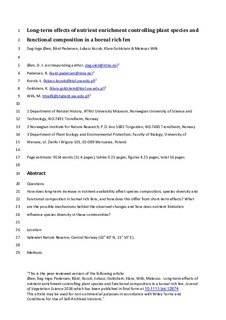| dc.description.abstract | Questions: How does long-term increase in nutrient availability affect species composition, species diversity and functional composition in boreal rich fens, and how does this differ from short-term effects? What are the possible mechanisms behind the observed changes, and how does nutrient limitation influence species diversity in these communities? Location: Sølendet Nature Reserve, central Norway. Methods: A full-factorial field experiment. Plots in two localities received one of following treatments (n = 3): no nutrient addition (control), N, P, K, NP, NK, PK and NPK addition. Cover of plant species was recorded before treatment, and after two and 15 years of treatment. Results: Two years of nutrient addition caused small changes in species composition, but addition of NP led to large increase in abundance of species with high ability to exploit the added nutrients—a direct result of the elimination of nutrient limitation in the communities. After 15 years of nutrient addition there were significant changes following three different pathways, one for each of N, P and NP addition. The addition of NP led to large community shifts, considerable species turnover and reduced species and functional richness, mainly caused by increase in cover of highly competitive and tussock-forming grasses like Deschampsia cespitosa, Festuca ovina and Molinia caerulea, out-competing other species, especially bryophytes. Addition of N led to smaller changes in species turnover, and without clear dominant species. Addition of P led to considerable species turnover, but no reduction in species or functional richness, and the bryophyte diversity increased. This is explained by the bryophytes’ association with N-fixing cyanobacteria, suggesting less N limitation and a greater ability to utilize the added P when vascular plants suffer from N shortage. In addition, bryophytes are more sensitive to low P availability, due to larger P requirements compared to vascular plants. There was no effect of K addition. Conclusions: Both N and P limitation is essential for the maintenance of high species diversity in boreal rich fens, and P limitation controls bryophyte diversity. From a management perspective, N and P limitation is vital in the conservation of boreal Rich fens or when a functional fen system is reestablished through restoration measures. Bryophyte diversity, Functional richness, Functional traits, Mycorrhizal associations, N fixation, Norway, Nutrient limitation, Rich fen vegetation, Sloping fen, Species diversity | nb_NO |
